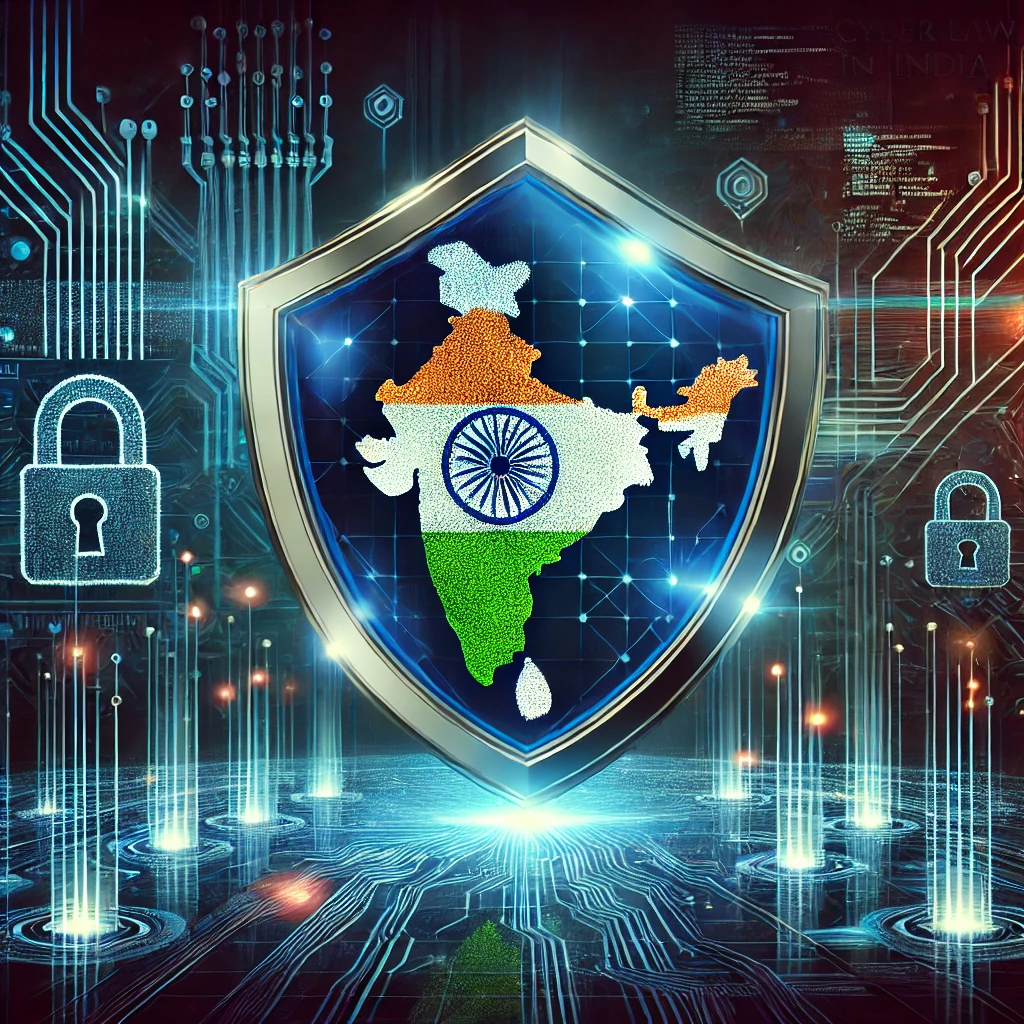
This article has been written by Satya Vrat Pandey , a final Year Law Student from Integral University Lucknow.

**This article has been selected for LegalOnus Law Journal (LLJ), Volume 1, Issue 3, 2024
Abstract
The rapid proliferation of technology and the internet in the contemporary digital age has highly changed the manner in which individuals and organizations interact, share ideas, and conduct commerce. As one of the largest online markets globally, India has seen a corresponding rise in cyber activity, which poses both opportunities and challenges. The need for a robust legal framework to regulate the digital landscape has never been more pressing. Cyber law in India evolves as a crucial protector of the digital realm, addressing issues related to online privacy, data protection, and criminality.
The Information Technology Act of 2000 serves as the foundation of cyber law in India, providing the legal framework to combat cyber offences and establishing a platform for electronic commerce. This legislation has evolved over the years via several changes, particularly the Information Technology (Amendment) Act of 2008, which expanded legal protections to include provisions for data privacy, cyberterrorism, and enhanced penalties for cybercrimes.
Despite these legal advancements, the implementation of cyber law in India encounters numerous challenges, including rapid technological progress that surpasses existing legislation, a significant deficiency in public awareness concerning cyber rights and responsibilities, and insufficient infrastructure and resources for law enforcement agencies tasked with enforcing these laws. The jurisdictional complexity arising from the global nature of the internet hinders international cyber law enforcement.
The Indian government must adopt a proactive approach, focussing on continuous legislative updates, public education initiatives, and enhancements in law enforcement capabilities to effectively address these challenges. India can establish a more secure digital landscape by fostering collaboration among many stakeholders, including the government, law enforcement, and the public, therefore ensuring that the benefits of technological advancement are harnessed while mitigating the risks associated with cyber assaults. Understanding and implementing cyber legislation will safeguard personal freedoms and contribute to the security and reliability of the evolving digital economy.
Keyword: Cyber Law, Privacy Laws, Intellectual Property Rights , Cybersecurity Policy , Online Defamation, Digital Security.
Introduction
The Information Technology Act, 2000 (IT Act) is India’s primary law governing cyber activities, enacted to provide legal recognition to electronic transactions and curb cybercrimes. It was introduced in response to the increasing use of digital platforms for commerce and communication, aligning India with global standards like the United Nations’ Model Law on Electronic Commerce. The Act addresses several key areas:
- Electronic Contracts: It grants legal validity to e-contracts, enabling businesses to function efficiently in the digital space.
- Digital Signatures: By legitimizing digital signatures, it ensures secure authentication of electronic records.
- Cybercrime Regulation: The Act defines and penalizes crimes like hacking, identity theft, data breaches, and cyberstalking.
- E-Governance: It facilitates government services online, making governance more accessible and transparent.
Significantly, the IT Act establishes the Certifying Authorities (CAs) and the Cyber Appellate Tribunal for resolving disputes and promoting trust in digital interactions. India’s digital revolution in the last two decades has transformed communication and significantly modified how individuals and businesses interact and execute transactions. The digital realm has seamlessly integrated into everyday life and has become an essential element of both personal and professional interactions due to the proliferation of the internet and mobile technology. The efficiency and convenience of digital platforms, including e-commerce, online banking, social networking, and telecommuting, have facilitated economic expansion and enhanced connectivity for millions of individuals. However, this rapid advancement has also given rise to several issues that pose significant threats to individuals and enterprises alike. In the contemporary digital landscape, issues such as cybercrime, data breaches, identity theft, and privacy violations have alarmingly grown prevalent.
The risks associated with the use of increasingly personal and sensitive data transferred online have intensified, prompting concerns over the integrity and security of online transactions. In light of these challenges, cyber law in India has gained significance as a mechanism to safeguard individuals and organisations from the many threats associated with the digital age. This regulatory framework aims to enhance the safe and secure use of digital technology while mitigating the risks associated with cyber operations. o address the challenges posed by the digital age, India requires a multi-pronged approach that combines legislative measures, technological advancements, and awareness initiatives. To combat cybercrime, there is a need for advanced threat detection tools powered by AI, strengthened cyber policing units, and amendments to the Information Technology Act, 2000,[1] to address emerging threats.
For preventing data breaches, strong encryption protocols, a zero-trust security framework, and compliance with global data protection standards like GDPR are essential. Identity theft can be mitigated through Multi-Factor Authentication (MFA), biometric verification, and real-time monitoring systems. To safeguard privacy, robust legislation such as India’s Digital Personal Data Protection Act of 2023,[2] should be enforced, along with privacy-by-design principles in technology and tools that allow users control over their data. Ensuring the integrity and security of online transactions requires the adoption of blockchain technology, mandatory end-to-end encryption in payment systems, and regular security audits.
Broader initiatives include implementing a National Cybersecurity Strategy, fostering public-private partnerships for innovative solutions, training law enforcement and judicial bodies in cyber laws, and strengthening international cooperation to address cross-border cybercrimes. These measures collectively aim to create a safe, secure, and trustworthy digital environment for individuals and enterprises alike.
Cyberlaw seeks to provide a secure digital environment by legislation governing online activities and transactions, hence fostering trust in technology and creativity. The need for robust cyber laws is paramount as India advances on its digital trajectory, since they are essential for safeguarding the rights and interests of individuals and enterprises in an increasingly interconnected society.[3]
Historical Context and Evolution of Cyber Law in India
In the late 1990s, the Indian government saw the need to establish a legislative framework to regulate electronic transactions and tackle the increasing prevalence of cybercrime issues.[4] This marked the start of the trajectory that cyber law will follow in India. The Information Technology Act of 2000 (IT Act) was enacted to affirm the legal validity of electronic transactions, provide a framework for data protection, and delineate charges related to cybercrime. The Information Technology Act was a pivotal moment that facilitated further advancements in cyberlaw. Since its creation, the Information Technology Act has seen many amendments to meet developing issues in the digital domain.
The Information Technology (Amendment) Act of 2008[5] notably broadened existing legislation by including measures for data security and cyberterrorism while also augmenting punishments for cyber offences. The formation of the Cyber Appellate Tribunal further offered a forum for resolving disputes and appeals related to breaches of cyber law.
Key Provisions of Cyber Law in India
The Information Technology (IT) Act encompasses several critical provisions addressing key aspects of cyber law. It provides legal recognition to electronic records and digital signatures, enabling secure online transactions and communication. The Act also emphasizes data protection and privacy, mandating guidelines for the collection, storage, and processing of personal information, while requiring organizations to adopt reasonable security practices to safeguard sensitive data. Additionally, it categorizes various cyber offences, such as hacking, identity theft, phishing, and cyberstalking, prescribing penalties to deter cybercrimes and offering victims legal recourse.
The Act outlines the role and responsibilities of intermediaries, like social media platforms and online service providers, granting them safe harbour protection from liability for third-party content, provided they exercise due diligence. It also addresses the regulation of online content, including issues like hate speech, obscenity, and defamation, empowering law enforcement agencies to act against violations. However, the IT Act faces limitations in addressing challenges posed by emerging technologies like blockchain and artificial intelligence (AI). These rapidly evolving technologies introduce complexities in areas such as decentralized governance, data ownership, and algorithmic accountability, which the Act does not adequately cover. This gap underscores the need for updating the legal framework to ensure its relevance and effectiveness in the face of technological advancements.
Challenges in the Implementation of Cyber Law
Despite the robust framework established by the Information Technology Act, 2000 (IT Act), India faces significant hurdles in the implementation of its cyber laws. The rapid pace of technological innovation, coupled with issues such as a lack of awareness, inadequate resources, and jurisdictional complexities, undermines the efficacy of these regulations.
1. Challenges Due to Rapid Technological Evolution
Cybercriminals continually develop sophisticated methods such as ransomware attacks and Advanced Persistent Threats (APTs),[6] often outpacing legislative updates. For instance, the WannaCry ransomware attack (2017),[7] which affected over 150 countries, including India, revealed gaps in India’s preparedness to tackle widespread cyber incidents. Despite the IT Act’s provisions, many affected Indian institutions lacked the tools and expertise to effectively respond.
2. Awareness Gaps Among Stakeholders
A lack of awareness about digital rights and cyber laws leaves individuals and organisations vulnerable. For example, during the Aadhaar data breach incidents, millions of Indians were exposed to potential misuse of their sensitive data. Many victims were unaware of their rights under laws such as the IT Act or how to seek redress.
3. Inadequate Infrastructure and Expertise
Law enforcement agencies often lack the technical expertise necessary to investigate and prosecute cybercrimes. The ATM hacking case of 2018, where Indian banks suffered significant losses due to malware attacks on ATMs, highlighted this limitation. Investigations revealed that outdated security systems and insufficient cyber forensics expertise in local enforcement hindered timely resolution.
4. Cross-Border Jurisdiction Issues
The global nature of the internet complicates enforcement. Cybercrimes often involve actors and servers located in different jurisdictions, making it difficult to determine the applicable law.
- Case Study of the Sony Pictures Hack (2014)[8]:- Though not directly involving India, this case demonstrates the difficulty in attributing cyberattacks across borders. The hack, allegedly conducted by North Korean actors, exploited vulnerabilities across various nations’ infrastructure. For Indian law enforcement, similar attribution issues arose during incidents like theCosmos Bank cyber heist (2018), where hackers allegedly from Pakistan and other nations siphoned ₹94 crore using malware and cloned cards. Cooperation with international agencies became critical, but jurisdictional ambiguities delayed the process.
- Case Study of the Silk Road Investigation[9]:- While this case primarily unfolded in the U.S., its lessons are pertinent for India. The investigation into the illegal online marketplace Silk Road relied on international collaboration. For India, enforcing laws against illicit activities on the dark web faces similar jurisdictional hurdles. Investigations into cases involving illegal drug trade or counterfeit currency on the dark web have often hit roadblocks due to non-cooperation from entities based in foreign jurisdictions.
5. Data Localization and Conflicting Laws
India’s increasing demand for data localisation, as outlined in the Draft Personal Data Protection Bill, clashes with global norms. For example, social media companies operating in India have faced challenges balancing compliance with local laws and foreign regulations like the General Data Protection Regulation (GDPR)[10] in the European Union.
The Role of Government and Law Enforcement
To address these difficulties, the government must proactively improve the framework of cyberlaw. Thus, this requires the ongoing enactment of legislative amendments to tackle growing dangers and technological progress, ensuring the legal system remains effective and relevant. The efficacy of public awareness initiatives relies on the education of the populace on cyber law, digital rights, and safe online practices. Information may be disseminated to a vast audience inside schools, universities, and community groups.[11] Law enforcement agencies must provide money and training to improve their ability to fight cybercrime. Through partnerships with information technology firms and cybersecurity experts, law enforcement agencies may get the resources and expertise required to proficiently address cyber threats.
The worldwide nature of cybercrime necessitates paramount coordination among international law enforcement authorities. The establishment of multinational alliances and treaties is advantageous for addressing cyber threats by promoting the flow of knowledge and resources.[12]
Conclusion
In conclusion, cyber law in India is a crucial protector of the digital realm, as it provides the necessary legal framework to address the intricacies of our linked online landscape. The advancement of technology is giving rise to new issues, underscoring the increasing need for cyber legislation. Legal systems must adapt concurrently with technological breakthroughs, including blockchain, artificial intelligence, and the Internet of Things (IoT). This will facilitate the minimization of emerging hazards and the establishment of strong safeguards for all consumers. To advance toward a safe digital environment, collaboration and active engagement from individuals, corporations, and communities are essential.
Strengthening public-private partnerships can foster the sharing of knowledge and resources, while establishing a national cybersecurity task force ensures coordinated responses to cyber threats. Promoting cybersecurity awareness campaigns and facilitating skill development in cybersecurity will empower individuals to protect themselves and navigate the digital realm effectively.
Furthermore, incentivizing research and innovation in cybersecurity, particularly in AI-based threat detection and secure IoT systems, can provide robust defenses. Mandating cybersecurity standards for IoT devices and enhancing international cooperation to establish unified cyber norms will also play pivotal roles. Governments must implement robust data protection laws aligned with global best practices to ensure accountability among corporations. Accessible reporting mechanisms and rapid response teams are critical to addressing incidents swiftly and minimising damage.
Corporations should build a culture of transparency by disclosing cybersecurity breaches and working with regulators to improve accountability while safeguarding sensitive data. The formulation of effective strategies to combat cybercrime relies on collaboration among government entities, technology firms, and law enforcement. A synergistic approach is essential to address existing risks and future challenges. By establishing a robust cyber legal framework, fostering trust, and creating a secure digital ecosystem through these measures, we can reconcile innovation with protection. The ultimate goal is to cultivate a flourishing digital environment where basic rights and freedoms harmoniously coexist with technological advancement. Together, we can ensure that the digital realm remains a domain of opportunity and security, benefiting individuals, enterprises, and society while promoting exceptional development and innovation.
[1] Information Technology Act, No. 21 of 2000,(India)
[2] Digital Personal Data Protection Act, No. 13 of 2023, (India).
[3] Simplilearn, What is Cyber Law?, Simplilearn (July 11, 2023), https://www.simplilearn.com/what-is-cyber-law-article.
[4] InfoSec Awareness, Cyber Laws of India, InfoSec Awareness (last visited Nov. 14, 2024), https://infosecawareness.in/cyber-laws-of-india.
[5] Information Technology (Amendment) Act, No. 10 of 2009, India Code (2009).
[6] Imperva, APT (Advanced Persistent Threat), Imperva, https://www.imperva.com/learn/application-security/apt-advanced-persistent-threat/ (last visited Nov. 14, 2024).
[7] Cloudflare, WannaCry Ransomware, Cloudflare, https://www.cloudflare.com/en-gb/learning/security/ransomware/wannacry-ransomware/ (last visited Nov. 14, 2024).
[8] Coverlink, Sony Pictures Entertainment Hack, Coverlink, https://coverlink.com/case-study/sony-pictures-entertainment-hack/#:~:text=From%20there%2C%20the%20film’s%20distribution,an%20advanced%20form%20of%20malware (last visited Nov. 14, 2024).
[9] Crime and Justice, Inside the Darknet Takedown of Silk Road, Crime and Justice, https://www.crimeandjustice.org.uk/publications/cjm/article/inside-darknet-takedown-silk-road (last visited Nov. 14, 2024).
[10] GDPR-Info, General Data Protection Regulation (GDPR) Compliance Guidelines, GDPR-Info, https://gdpr-info.eu (last visited Nov. 15, 2024).
[11] UpGuard, Cybersecurity Regulations in India, UpGuard (last visited Nov. 14, 2024), https://www.upguard.com/blog/cybersecurity-regulations-india.
[12] World Economic Forum, Partnership Against Cybercrime, World Economic Forum (last visited Nov. 14, 2024), https://www.weforum.org/projects/partnership-against-cybercime/.






